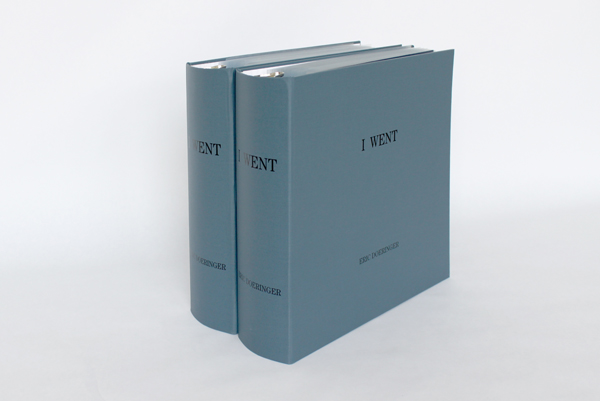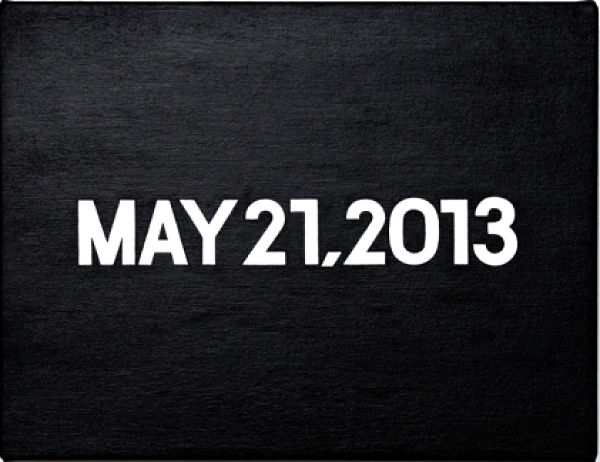 Eric Doeringer, May 21, 2013 (after On Kawara), 10” x 13”, Acrylic on canvas, 2013. Courtesy of Katharine Mulherin Contemporary Art Projects.
Eric Doeringer, May 21, 2013 (after On Kawara), 10” x 13”, Acrylic on canvas, 2013. Courtesy of Katharine Mulherin Contemporary Art Projects.
All summer long, Eric Doeringer has been presenting a series of short two-week exhibitions at Katharine Mulherin Contemporary Art Projects which unite to create Survey. For those who appreciate humour within conceptual art, Doeringer’s exhibition is sure to grant viewers with a chuckle from its cheeky and audacious content, while providing insight towards his broader critique of recent art history. The self-proclaimed bootleg artist is known for his imitations which subvert the intention of an original by exposing contradictions. In particular, Survey features a number of knock-off works from seminal artists of the twentieth-century. The exhibition presents itself as a homage to famous artists, a commentary on the rapid commercialism of the art industry, and a remark on the inconsistencies within conceptual art.
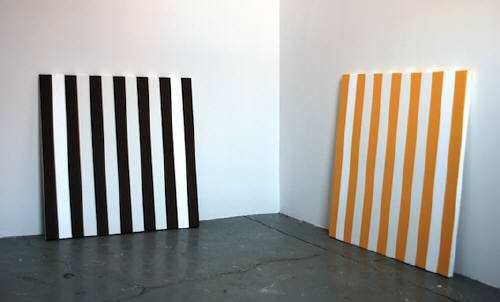 Eric Doeringer, Stripe Paintings (after Daniel Buren), Various sizes, White acrylic on striped fabric, 2009. Courtesy of Katharine Mulherin Contemporary Art Projects
Eric Doeringer, Stripe Paintings (after Daniel Buren), Various sizes, White acrylic on striped fabric, 2009. Courtesy of Katharine Mulherin Contemporary Art Projects
Survey is compiled of works from two of Doeringer’s projects: Conceptual Art Relations (2008-2012) and Bootlegs (2001-2012). In the passing months, Doeringer re-created the wall drawings of Sol LeWitt, the stains of Ed Ruscha, and stills from Andy Warhol’s Empire. The entire exhibition plays on the often heard “I could do that” attitude towards conceptual art and runs with it to give the ultimate message “too bad you didn’t”. Doeringer exaggerates the art of duplication to the point where plagiarism becomes a significant basis for the work’s concept. As reproductions of undeniably influential works are duplicated in modern times, Doeringer forces viewers to re-examine the greats of the past for why they were established as such, how revolutionary their ideas and works were, and how significant of a role time plays in any artistic practice.
 Eric Doeringer, I Went ( After On Kawara ), 8.5” x 11” (drawings), 11.5” x 12 x 3.5” (binders), Ink on laser prints in two three-ring binders, 2010. Courtesy of Katharine Mulherin Contemporary Art Projects
Eric Doeringer, I Went ( After On Kawara ), 8.5” x 11” (drawings), 11.5” x 12 x 3.5” (binders), Ink on laser prints in two three-ring binders, 2010. Courtesy of Katharine Mulherin Contemporary Art Projects
However, aside from paying tribute towards the contributions of certain artists, Doeringer’s imitation extends far beyond mere flattery by challenging the foundations of conceptual art through a method of usurpation. The conceptual art movement brought about ideas such as the dematerialization of the art object and the insignificance of the artist’s hand, while focusing on the ideas and gestures within a piece to demonstrate its value. LeWitt’s pieces are intended to be read as instructions and most of Warhol’s practice was based on commercial methods of production. Doeringer is presenting viewers with the same concepts that are praised in the art world and market. He highlights his consistency and focus on a work`s idea by inserting slight tweaks to each artist`s visual trademarks without altering the overall concept. On Kawara’s self-documentation is brought to the year 2013, Empire was shot through Doeringer’s New York studio, and Warhol’s Coca-Cola bottles are modeled in plastic. However, although Doeringer meticulously follows each artist’s method and idea, he achieves nowhere near the same level of fame or fortune as his predecessors, bringing a dose of realism to conceptual art’s idealism that a good idea is all that matters.
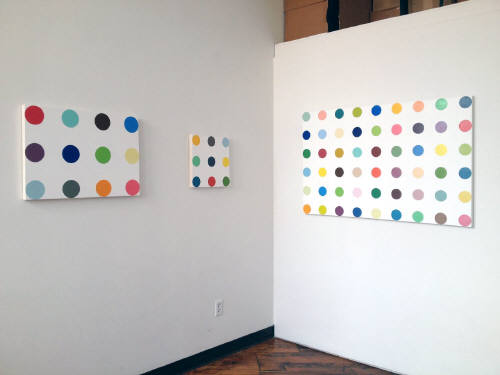 Eric Doeringer, Spot Paintings (after Damien Hirst), Various sizes, House Paint on canvas, 2012. Courtesy of Katharine Mulherin Contemporary Art Projects
Eric Doeringer, Spot Paintings (after Damien Hirst), Various sizes, House Paint on canvas, 2012. Courtesy of Katharine Mulherin Contemporary Art Projects
Similar to Conceptual Art Relations, Bootlegs features small handmade copies of the works of artists such as Warhol and Hirst. This specific project began as a small stand on 24th Street in New York’s Chelsea gallery district, where Doeringer sold cheap imitations of art on the sidewalk as if they were counterfeit handbags. By doing so, the artist perpetuated the fame of the artist he imitated while commenting on their diluted content through his process of dissemination. Currently, Bootleg features imitations of over 100 modern and contemporary artists, many of which can be seen at Katherine Mulherin Contemporary Art Projects as well as No Fountation next door. Bootlegs was eventually carried to notable art events such as the 2004 Whitney Biennial, where he sold Bootleg versions of pieces in the exhibition. Doeringer has stated that the project was originally intended as guerilla interventions, but eventually, he was invited to sell these works in institutions and established art venues. Thus, Doeringer’s criticism becomes full circle. As an artist who pokes fun at the concepts of the recent past, his works also falls under the same trap of commercialization which he is criticizing. It is uncertain whether Doeringer had predicted that his project’s success would ultimately contribute to the irony of his concept. However, given his study of the past and his shameless claim that he has “done anyone who’s anyone in the art world”, it is likely that Doeringer has set himself up as an example in order to expose the inescapable nature from contradiction and industry within the art world. In many ways, Doeringer demonstrates the fallacy within conceptual art while also noting its innovative contributions. Ultimately, Survey sends a hopeful message through a satirical form by demonstrating the shifting attitude towards conceptual art from “I could do that” to the postmodern belief and that “I could expand on that”.
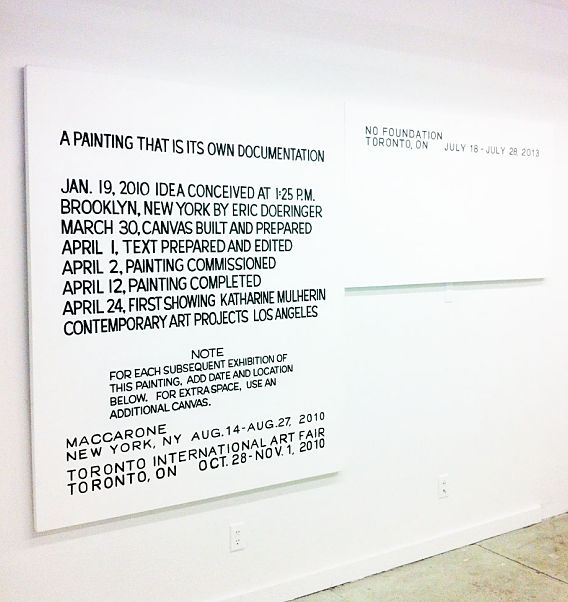 Eric Doeringer, A Painting That Is Its Own Documentation (after John Baldessari), 68” x 56.5”, Acrylic on canvas, 2010. Courtesy of Katharine Mulherin Contemporary Art Projects
Eric Doeringer, A Painting That Is Its Own Documentation (after John Baldessari), 68” x 56.5”, Acrylic on canvas, 2010. Courtesy of Katharine Mulherin Contemporary Art Projects
Shellie Zhang
*The show is on display till September 8, 2013 at Katharine Mulherin Contemporary Art Projects, 1082 + 1086 Queen Street West. Gallery hours: Thursday to Saturday: 12 – 6 p.m. Sunday: 1 – 5 p.m. or by appointment.

